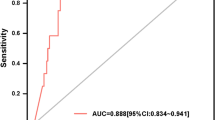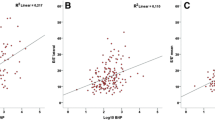Abstract
Objective
A high N-terminal pro-brain natriuretic peptide (NT-proBNP) level provides significant prognostic information on patients with coronary artery disease (CAD). It is unclear whether aortic distensibility (AD), which reflects the aortic stiffness, and the extent and complexity of CAD, assessed with the SYNTAX score (SS), affect the secretion of NT-proBNP in stable CAD. We aimed to investigate the relationship between NT-proBNP levels and AD as well as with the extent and complexity of CAD in stable CAD patients.
Methods
The study included 411 patients with stable CAD (mean age = 61.7 ± 9.9 years, male/female = 247/164). The patients were divided into two groups according to the median NT-proBNP value (NT-proBNPlow group < 114 pg/ml and NT-proBNPhigh group ≥ 114 pg/ml). AD was calculated from the echocardiographically derived ascending aorta diameters and hemodynamic pressure measurements. Coronary angiography was performed and SS was determined in all patients. NT-proBNP and other biochemical markers were measured in all subjects.
Results
The AD and ejection fraction values of the NT-proBNPhigh group were lower and their SS levels were higher compared with those from the NT-proBNPlow group (p < 0.05, for all). The NT-proBNP level was independently associated with AD (β = -0.378, p < 0.001), SS (β = 0.262, p < 0.001), and ejection fraction (β = − 0.295, p < 0.001) on multiple linear regression analysis.
Conclusion
NT-proBNP was independently associated with an impaired elastic property of the aorta and with the extent and complexity of CAD as well as with left ventricular systolic dysfunction.
Zusammenfassung
Ziel
Ein hoher Spiegel an NT-proBNP („N-terminal pro-brain natriuretic peptide“) liefert bei Patienten mit koronarer Herzkrankheit (KHK) wichtige Informationen zur Prognose. Unklar ist, ob die Aortendehnbarkeit (AD), welche die Aortensteifigkeit widerspiegelt, sowie das mit dem SYNTAX-Score (SS) bestimmte Ausmaß und die Komplexität der KHK Einfluss auf die Sekretion von NT-proBNP bei stabiler KHK haben. Ziel der Studie war es, den Zusammenhang zwischen NT-proBNP-Spiegeln einerseits und AD sowie Ausmaß und Komplexität der KHK andererseits bei stabiler KHK zu untersuchen.
Methoden
Die Studie umfasst 411 Patienten mit stabiler KHK (Durchschnittsalter: 61,7 ± 9,9 Jahre, m/w: 247/164). Die Patienten wurden je nach Mittelwert für NT-proBNP in 2 Gruppen unterteilt (NT-proBNPlow-Gruppe < 114 pg/ml und NT-proBNPhigh-Gruppe ≥ 114 pg/ml). Die AD wurde aus den echokardiographisch ermittelten Durchmessern der Aorta ascendens und hämodynamischen Druckmessungen berechnet. Bei allen Patienten wurde eine Koronarangiographie durchgeführt und der SS ermittelt. NT-proBNP und andere biochemische Marker wurden bei sämtlichen Teilnehmern bestimmt.
Ergebnisse
Die Werte für die AD und die Ejektionsfraktion waren in der NT-proBNPhigh-Gruppe niedriger und deren SS-Werte höher als in der NT-proBNPlow-Gruppe (p < 0,05 für alle). Der NT-proBNP-Spiegel war in der multiplen linearen Regressionsanalyse unabhängig mit der AD (β = −0,378; p < 0,001), SS (β = 0,262; p < 0,001) und der Ejektionsfraktion (β = − 0,295; p < 0,001) verknüpft.
Schlussfolgerung
NT-proBNP war unabhängig mit eingeschränkten elastischen Eigenschaften der Aorta sowie dem Ausmaß und der Komplexität der KHK verknüpft, ebenso wie mit einer linksventrikulären systolischen Dysfunktion.


Similar content being viewed by others
References
Lemos JA de, Morrow DA, Bentley JH et al (2001) The prognostic value of B-type natriuretic peptide in patients with acute coronary syndromes. N Engl J Med 345:1014–1021
Omland T, Persson A, Ng L et al (2002) N-terminal pro-B-type natriuretic peptide and long-term mortality in acute coronary syndromes. Circulation 106:2913–2918
Jernberg T, Stridsberg M, Venge P, Lindahl B (2002) N-terminal pro brain natriuretic peptide on admission for early risk stratification of patients with chest pain and no ST-segment elevation. J Am Coll Cardiol 40:437–445
Levin ER, Gardner DG, Samson WK (1998) Natriuretic peptides. N Engl J Med 339:321–328
Sahinarslan A, Cengel A, Okyay K et al (2005) B-type natriuretic peptide and extent of lesion on coronary angiography in stable coronary artery disease. Coron Artery Dis 16:225–229
Sakuragi S, Okawa K, Iwasaki J et al (2007) Aortic stiffness is an independent determinant of B-type natriuretic peptide in patients with coronary artery disease. Cardiology 107:140–146
Bibbins-Domingo K, Gupta R, Na B Wu AH et al (2007) N-Terminal fragment of the prohormone brain-type natriuretic peptide (NT-proBNP), cardiovascular events, and mortality in patients with stable coronary heart disease. JAMA 297:169–176
Omland T, Sabatine MS, Jablonski KA et al (2007) PEACE Investigators. Prognostic value of B-Type natriuretic peptides in patients with stable coronary artery disease: the PEACE Trial. J Am Coll Cardiol 50:205–214
Zieman SJ, Melenovsky V, Kass DA (2005) Mechanisms, pathophysiology, and therapy of arterial stiffness. Arterioscler Thromb Vasc Biol 25:932–943
Eren M, Gorgulu S, Uslu N et al (2004) Relation between aortic stiffness and left ventricular diastolic function in patients with hypertension, diabetes, or both. Heart 90:37–43
Johnson KR, Hoagland TM, Olson KR (2011) Endogenous vascular synthesis of B-type and C-type natriuretic peptides in the rainbow trout. J Exp Biol 214:2709–2717
Suga S, Nakao K, Hosoda K et al (1992) Receptor selectivity of natriuretic peptide family, atrial natriuretic peptide, brain natriuretic peptide, and C-type natriuretic peptide. Endocrinology 130:229–239
Huang Y, Song Y, Mai W et al (2011) Association of N-terminal pro brain natriuretic peptide and impaired aortic elastic property in hypertensive patients. Clin Chim Acta 412:2272–2276
Dawson A, Davies JI, Morris AD, Struthers AD (2005) B-type natriuretic Peptide is associated with both augmentation index and left ventricular mass in diabetic patients without heart failure. Am J Hypertens 18:1586–1591
Yildiz A, Gur M, Yilmaz R, Demirbag R (2008) The association of elasticity indexes of ascending aorta and the presence and the severity of coronary artery disease. Coron Artery Dis 19:311–317
Schiller NB, Shah PM, Crawford M et al (1989) Recommendations for quantitation of the left ventricle by two-dimensional echocardiography. American Society of Echocardiography Committee on Standards, Subcommittee on Quantitation of Two-Dimensional Echocardiograms. J Am Soc Echocardiogr 2:358–367
Stefanadis C, Stratos C, Vlachopoulos C et al (1995) Pressure diameter relation of the human aorta. A new method of determination by the application of a special ultrasonic dimension catheter. Circulation 92:2210–2219
Stefanadis C, Dernellis J, Vlachopoulos C et al (1997) Aortic function in arterial hypertension determined by pressure–diameter relation: effects of diltiazem. Circulation 96:1853–1858
Sianos G, Morel MA, Kappetein AP et al (2005) The SYNTAX score: an angiographic tool grading the complexity of coronary artery disease. EuroIntervention 1:219–227
Bibbins-Domingo K, Ansari M, Sciller NB (2003) B-type natriuretic peptide and ischemia in patients with stable coronary artery disease: data from the Heart and Soul study. Circulation 108:2987–2992
Selvais PL, Donckier JE, Robert A et al (1998) Cardiac natriuretic peptide for diagnosis and risk stratification in heart failure: influences of left ventricular dysfunction and coronary disease on cardiac hormonal activation. Eur J Clin Invest 28:636–642
Palazzuoli A, Gennari L, Calabria P et al (2005) Relation of plasma brain natriuretic peptide levels in non-ST-elevation coronary disease and preserved systolic function to number of narrowed coronary arteries. Am J Cardiol 96:1705–1710
Wykrzykowska JJ, Garg S, Girasis C et al (2010) Value of the SYNTAX score (SX) for risk assessment in the “all-comers” population of the randomized multicenter LEADERS Trial. J Am Coll Cardiol 56:272–277
Girasis C, Garg S, Räber L et al (2011) SYNTAX score and clinical SYNTAX score as predictors of very long-term clinical outcomes in patients undergoing percutaneous coronary interventions: a substudy of SIRolimus-eluting stent compared with pacliTAXel-eluting stent for coronary revascularization (SIRTAX) trial. Eur Heart J 32:3115–3127
Marumoto K, Hamada M, Hiwada K (1995) Increased secretion of atrial and brain natriuretic peptides during acute myocardial ischemia induced by dynamic exercise in patients with angina pectoris. Clin Sci (Lond) 88:551–556
Schirger JA, Grantham JA, Kullo IJ et al (2000) Vascular actions of brain natriuretic peptide: modulation by atherosclerosis and neutral endopeptidase inhibition. J Am Coll Cardiol 35:796–801
Johnson KR, Hoagland TM, Olson KR (2011) Endogenous vascular synthesis of B-type and C-type natriuretic peptides in the rainbow trout. J Exp Biol 214:2709–2717
Maeder MT, Mariani JA, Kaye DM (2010) Hemodynamic determinants of myocardial B-type natriuretic peptide release: relative contributions of systolic and diastolic wall stress. Hypertension 56:682–689
Goto T, Ohte N, Fukuta H et al (2012) Relationship between effective arterial elastance, total vascular resistance, and augmentation index at the ascending aorta and left ventricular diastolic function in older women. Circ J 77:123–129. doi:10.1253/circj.CJ-12–0733
Davis KM, Fish LC, Minaker KL, Elahi D (1996) Atrial natriuretic peptide levels in the elderly: differentiating normal aging changes from disease. J Gerontol A Biol Sci Med Sci 51:M95–M101
Sayama H, Nakamura Y, Saito N, Kinoshita M (1999) Why is the concentration of plasma brain natriuretic peptide in elderly inpatients greater than normal? Coron Artery Dis 10:537–540
Redfield MM, Rodeheffer RJ, Jacobsen SJ et al (2002) Plasma brain natriuretic peptide concentration: impact of age and gender. J Am Coll Cardiol 40:976–982
Conflict of interest
On behalf of all authors, the corresponding author states that there are no conflicts of interest.
Author information
Authors and Affiliations
Corresponding author
Rights and permissions
About this article
Cite this article
Şahin, D., Gür, M., Elbasan, Z. et al. NT-proBNP is associated with SYNTAX score and aortic distensibility in patients with stable CAD. Herz 38, 922–927 (2013). https://doi.org/10.1007/s00059-013-3767-5
Received:
Revised:
Accepted:
Published:
Issue Date:
DOI: https://doi.org/10.1007/s00059-013-3767-5




